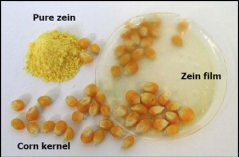Project
Encapsulation properties of corn protein zein
Jacob Bouman (WUR & UEA), Susan Barker (UEA) & Paul Venema (WUR)
In this research the goal is to use the corn protein zein as encapsulation material for active ingredients (AI) or drugs by the use of hot melt extrusion.

The corn storage protein zein has already been used in numerous industrial applications varying from buttons, adhesives to coating for paper cups. Also the Pharmaceutical and food industries are showing commercial interest in the protein, because of its ability to form tough, glossy, hydrophobic grease-proof coatings while also providing an antimicrobial barrier. Because of these promising characteristics the potential encapsulation properties of Zein are investigated in this project.
Both in the Pharmaceutical and Food industries there is much emphasis in understanding the release of the AI after consumption of the product. In some cases, AI release into the small intestine after exposure to the aggressive and acidic environment of the stomach is desired. In other cases, a slow and consistent AI release throughout the gastro-intestinal tract is preferred.
In previous research, a traditional ambient temperature wet mass extrusion process was used to generate a prototype Zein/AI matrix. The AI release, however, was in-between instant and controlled. The product formed from a hot melt extrusion process is expected to be different in structure and performance to the pwet mass extrusion product, and may produce a more desirable AI release profile. It is this concept which will be explored in this thesis.
